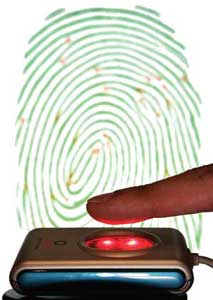DHS Special Report | Agencies Look for a Match on Fingerprint Systems


Connecting state and local government leaders
The FBI and Homeland Security Department are closing in on a significant milestone that will get the agencies' fingerprint image systems a step closer to their ultimate goal of communicating seamlessly.

Photo by Newscom
But officials familiar with the program
note that until DHS upgrades its existing
database to accept 10 fingerprints, and
the FBI substantially revamps its Integrated
Automated Fingerprint Identification
System database, the interoperability
of IAFIS and DHS' Automated Biometric
Identification System, known at IDENT,
will remain years away.
'They've been fighting this thing for 10
years, and they've spent a lot of money,'
said a former senior DHS official who
spoke on condition of anonymity. 'My bet
is that they won't get it solved until you
get Next Generation IAFIS.'
Still, DHS, the FBI and the State Department
have started the groundwork to
make the systems interoperable, and they
expect to reach an interim data-sharing
model this September. The agencies hope
to reach full interoperability by 2010, government
officials say.
Watch-list review
IDENT'the engine that supplies DHS'
U.S. Visitor and Immigration Status Indicator
Technology program with fingerprint
data'relies on data and prints collected
domestically by DHS and overseas
by State Department officials from foreigners
who wish to obtain visas. The
prints are checked and verified by DHS to
ensure that the person seeking the visa is
not on a terrorist watch list.
IAFIS is a 10-print criminal-justice database
that contains information on individuals
with outstanding wants and warrants.
The effort to link the systems could be
further postponed by an expected delay in
the solicitation for Next Generation
IAFIS, industry observers say.
The FBI planned to release a request for
proposals this October, but now it will
likely be delayed until sometime next
year, said Megan Gamse, a manager at
market research firm Input of Reston, Va.
FBI officials would not comment on any
potential delay.
Under the interim data-sharing model,
State, Justice and DHS will contribute
biometric data, including the FBI's wants
and warrants information, DHS' data on
aliens who have waived their right to see
an immigration judge, and State's Category
One Critical Visa Refusal records of individuals
not eligible to enter the country.
'My bet is that they won't get it solved until you get Next Generation IAFIS.' FORMER SENIOR DHS OFFICIAL
The interim solution 'will help these
agencies identify individuals that present
a potential risk to public safety or that are
applying for positions of national security
or public trust,' according to the FBI.
By making the databases interoperable,
law enforcement and diplomatic officials
will have real-time access to information
that could prevent a suspected terrorist
from entering the country, or find an individual
who has overstayed his visa requirements.
It also will let border security
officials detain, or help the law enforcement
community find, criminals with
outstanding wants and warrants.
'Our [state and local law enforcement]
customers had no access to DHS data, no
access to fingerprint data,' said Tom
Bush, assistant director of Justice's Criminal
Justice Information Services division.
'That's what we're doing. They're going to
have access to all the wants and warrants,
updated on an almost real-time basis.'
The information also will be shared with
local law enforcement as well as authorized,
noncriminal justice agencies.
But until DHS moves IDENT to a 10-
print system'as promised last summer
by secretary Michael Chertoff'and the
FBI moves forward on Next Generation
IAFIS, interoperability between the two
systems will be limited, officials say.
Moving to a 10-print system 'is a major
effort and clearly it is directly tied to our
interoperability effort,' Bush said.
The IAFIS upgrade also is key to this effort.
It went live in July 1999 and was developed
by integrators Northrop Grumman
Corp., Lockheed Martin Corp. and
Science Applications International Corp.
It is written primarily in C and runs on
the HP-UX operating system.
Bush said the system is built largely on
1990s technology and is in need of a significant
retooling.
Chuck Archer, who held Bush's job when
the bureau was rolling out IAFIS, agreed
that the system is aged. 'The problem with
the database at the FBI is that it is so large,
it takes lots and lots of horsepower just to
get it to do what [it] has to do,' said
Archer, who is now vice president of Identix
Inc. of Minnetonka, Minn., a multibiometric-
technology company.
For example, Bush said, IAFIS was built
to ideally process 62,000 prints a day, but
as recently as this past April processed
105,000 in a 24-hour period.
Although technical requirements are
still being worked out, Bush said the new
IAFIS could have the ability to take palm
prints, iris and facial scans, and even
DNA samples.
NEXT STORY: DHS Special Report | Who's Who at the Border




